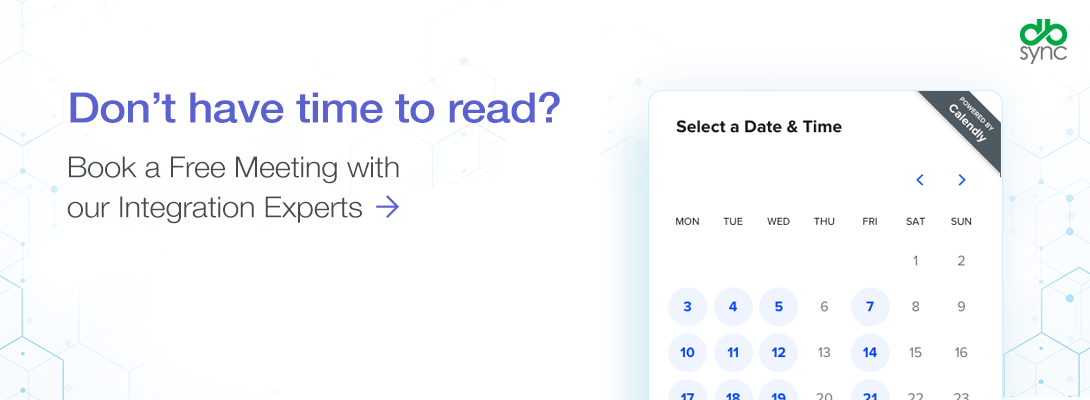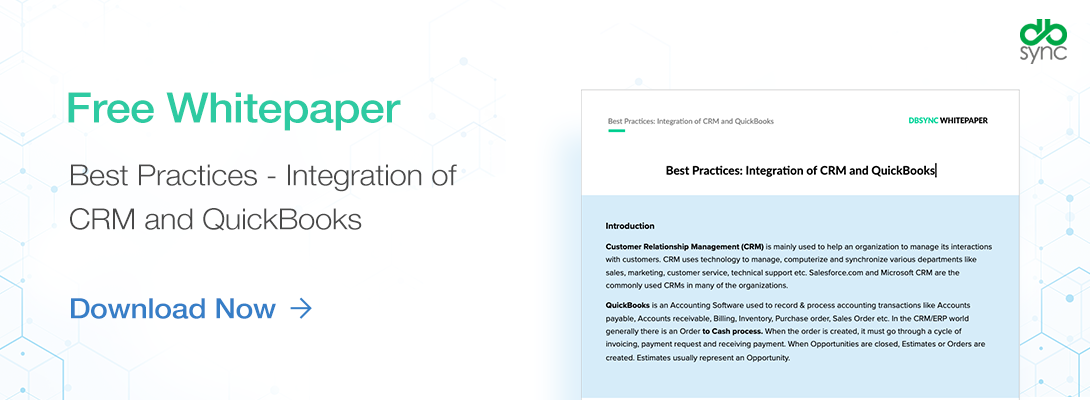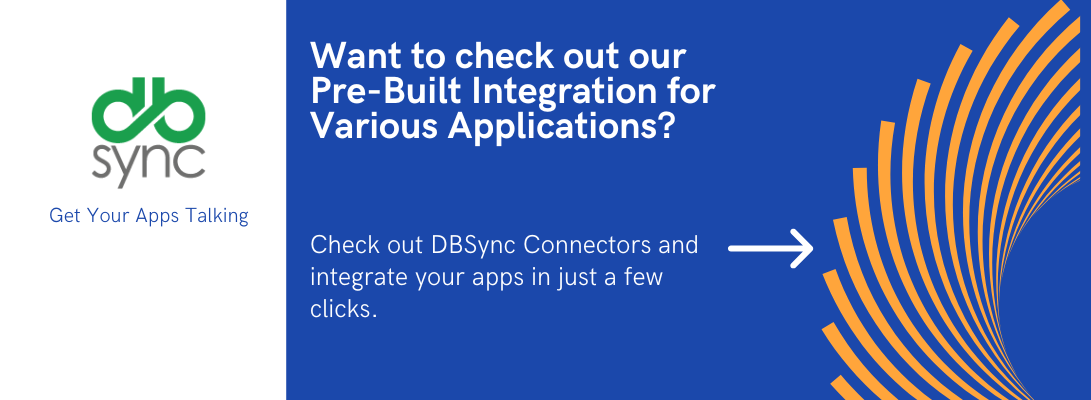How to Get More Out of your Data Integration Strategy.
Imagine running a Financial institution, banking services or retail investment company with multiple branches across dozens of locations and having multiple instances of CRMs(Like Salesforce) and multiple Sage Intacct or Netsuite accounts and data warehouses, along with having to cope with compliances like SOX and FINRA alongside having consistent data backup and replication.
On top of it, you may run multiple front-end, POS, and automation tools, and the organization can have multiple online and offline data sources.
Scenarios like this are common in today’s technology-driven businesses, leading to data silos.
As per McKinsey’s findings, companies that heavily depend on data and make informed decisions are “increasing profits by 93%; boosting sales by 82%; and improving the speed of sales growth by 112%.”
Data silos can be a major obstacle to effective data management and decision-making. When there’s a wall between two or more data sets, it is difficult to get a complete picture of your business operations.
This lack of visibility can prevent you from accurately predicting market trends, understanding customer behavior patterns, and making informed decisions based on your data.
In many cases, data silos are caused by poor customer data integration or lacking data orchestration.
These issues can arise when different departments within an organization use different software systems that don’t communicate with each other.
According to recent studies, only 3% of companies’ data meets basic data quality standards. This means that for most businesses, there is significant room for improvement in data management practices.
If your company struggles to address its business needs with the available data, it may be time to re-evaluate your customer data integration strategy.
You can gain a more comprehensive view of your organization’s operations by improving your approach to customer data integration and breaking down the barriers between disparate systems.
This increased visibility will enable you to make better-informed decisions and drive growth opportunities for your business.
So if you want to unlock the full potential of your company’s data assets, it’s important to take steps toward breaking down those pesky silos and ensuring that all departments have access to valuable insights.

What is a Data Integration Strategy?
A data integration strategy is a plan to manage, integrate, and govern the use of data across different systems in an enterprise.
It ensures that the right information is always available when needed and provides valuable insights into how that data can be used effectively to make informed business decisions.
Data integration strategies are essential in today’s digital world, where businesses need to access, share, and analyze vast amounts of data from multiple sources quickly and securely.
In recent years customer data integration (CDI) has gained pivotal importance in enterprise data strategy.
Customer data integration combines data from multiple source systems into a single, unified view.
This unified view gives customers an accurate picture of all customer information in one place. With this single view, businesses can better understand their customer’s needs and behaviors to make more informed decisions.
What are the types of enterprise data integration?
Enterprise data integration involves the collection, transformation and delivery of data from multiple sources to provide an integrated view of information.
Cloud-based solutions such as integrated platform-as-a-service (IPaaS) have become increasingly popular in recent years due to their scalability, reliability, and cost-effectiveness.
IPaaS offers a comprehensive suite of services for connecting different applications to enable seamless data transfer, data cleansing, and data migration.
IPaaS can be used to quickly build and deploy cloud-based applications and services and monitor and manage the performance of those applications in real-time.
By leveraging Cloud Data Integration and IPaaS solutions, you can get more out of your enterprise data integration strategy.
These solutions can help you integrate your core applications and services, generate data warehouses, ensure data security and compliance, and save time by streamlining your development process.
The types of enterprise data integration include
- Cloud Data Integration & IPaaS,
- Data Lake Integration,
- Extract Transform Load (ETL),
- Real-Time Data Replication
- Business Process Management (BPM).
Cloud Data Integration provides a cost-effective way to integrate cloud applications while allowing for scalability and reliability.
Data Lake Integration enables users to access data in its native format, allowing for more sophisticated analytics. Extract Transform Load (ETL) facilitates the movement of structured data between systems.
Real-Time Data Replication ensures the most current data version is available when needed. And Business Process Management (BPM) allows for data transfer, cleansing, and migration automation.
Cloud Data Integration and IPaaS solutions provide a powerful way to get more out of your enterprise data integration strategy. By leveraging these technologies, organizations can ensure that their data is available when needed and provide valuable insights into how it can be used effectively to make informed business decisions.

Where do you start with a data integration strategy?
When it comes to enterprise data integration, the most crucial factor is that you have a clear plan in place before beginning.
Align the company’s goals, objectives, and data governance strategy:
A successful data integration strategy requires careful planning and implementation that aligns with the organization’s mission, values, and governance structure.
Before developing a comprehensive data integration strategy, ensuring that it meets your organization’s specific goals and objectives is essential.
It should also be designed to ensure accessibility and transparency across all departments for teams to work collaboratively on projects.
This involves understanding which data will help them achieve those objectives and goals. Data leaders can effectively lead the process by aligning the data integration strategy with the company’s mission, values, and data governance strategy.

Here are the step-by-step instructions for creating a data integration plan:

Align the Roles and Responsibilities:
Each role and responsibility should be clearly defined to create accountability throughout the adoption process.

Create an Execution Strategy:
Once you have your plan ready, it’s time to start by assessing any existing software infrastructure you might already have in place that could help streamline your efforts while minimizing disruption or downtime as much as possible.
Then identify which tools or techniques are necessary for successful implementation – such as APIs or ETL processes – depending on your project’s complexity.
Finally, develop a rollout plan that clearly outlines timelines and roles, so everyone involved knows their part in ensuring everything runs smoothly during launch day.
The process of integrating enterprise data can be broken down into several steps:

Data Integration strategy: Factors You should consider.
When determining the best approach for an enterprise data integration strategy, several factors need to be considered:
- Data sources – what formats are being used?
- Data quality – how will quality issues be addressed?
- Governance – what level of governance needs to be achieved?
- Security – what security measures are needed to protect the data?
Data Integration Strategy: Factors You Can’t Ignore
- ETL and ELT platforms save time and streamline data processing for businesses to focus on insights
- Cloud-based data integration platforms offer scalability, secure data transfer, high availability, and lower costs
- Data quality, governance, and security are key considerations for an effective enterprise data integration strategy
- Tools with enhanced visibility into performance metrics help make informed decisions to improve usability, and efficiency and reduce costs
- The right combination of IPaaS, BPM, ETL/ELT tools, Cloud Services, and Data Quality/Governance/Security solutions can unlock hidden value in data, and reduce complexity, cost, and time
- Cloud technologies will continue to shape enterprise data management, making it easier to maximize ROI with the right approach and tools
What data should be integrated?
In today’s digital age, companies are generating an unprecedented amount of data from multiple sources.
This data is spread across various departments and systems, making gaining a unified view of the company’s operations difficult.
This is where enterprise data integration comes into play, helping to combine data from multiple sources to provide a comprehensive view of the organization.
But what enterprise data should be integrated? Here are some examples:
E-commerce integration:
One area where data integration can be particularly beneficial is in the integration of e-commerce data with other business functions.
By integrating e-commerce data with finance, sales, and marketing, companies can gain valuable insights into customer behavior, preferences, and buying patterns. This can help them to optimize their product offerings, target the right audiences, and increase revenue.
Human Resources Integration:
Another area where data integration can be beneficial is human resources. Integrating HR data with other business functions such as finance, payroll, and operations can provide a holistic view of the organization’s workforce.
This can help companies to identify areas for improvement, such as skill gaps or inefficiencies, and develop strategies to address them.
Finance Integration
Finance is also an area where data integration can be beneficial. Integrating finance data with other business functions such as sales, marketing, and procurement can help companies to manage their finances better, reduce costs, and improve financial performance.
This can also help companies to identify new revenue streams and improve their financial forecasting.
Sales and CRM Integration:
CRM integration is another area where data integration can be beneficial. Companies can better understand their customers’ needs, preferences, and behavior by integrating customer relationship management data with other business functions, such as sales and marketing.
This can help them to tailor their marketing efforts, improve customer engagement, and increase sales.
Ultimately, the enterprise data that should be integrated will depend on the company’s specific needs and objectives.
It’s essential to consider the business processes, data sources, and systems most critical to the organization’s success.
By identifying these areas and developing a comprehensive data integration strategy, companies can gain a unified view of their operations, improve decision-making, and drive business growth.

How Does an Enterprise Data Integration Strategy Create Business Value?
- Enterprise data integration enables efficient and effective use of data, providing businesses with greater visibility and insights for informed decision-making.
- It also reduces operational costs by streamlining workflows and eliminating manual processes.
- Cloud data integration provides scalability, security, and cost-effectiveness, allowing businesses to access and manage large volumes of data, staying competitive in the digital world.
- Combining IPaaS and BPM tools maximize the value of data assets by enabling seamless data flow between applications and providing visibility into inefficiencies.
- An effective enterprise data integration strategy is essential for any business, and cloud-based solutions provide the necessary infrastructure to ensure secure and accessible data resources, maximizing business value.
- Furthermore, leveraging the cloud to access and manage large volumes of data quickly and securely allows enterprises to stay competitive in today’s digital world. What are the Benefits of Cloud Data Integration?

Benefits of Data Integration:

Challenges with Enterprise Data Integration
Integration challenge with data:
Integrating data across multiple cloud-based and on-premise applications is one of the biggest challenges businesses face.
With each application storing data in its format and structure, it can take time to ensure that data is accurate and consistent across all systems.
Here are some common data integration challenges:
There are several common challenges that B2B companies may face when integrating data from multiple apps:
- Data quality & Data Lags: Ensuring that the data being integrated is accurate, complete, and consistent can be a challenge, especially if the data is being pulled from multiple sources at the right time.
- Data formatting: Different apps may store data in different formats, making it challenging to integrate the data meaningfully.
- Security: Ensuring that sensitive data is protected during integration is essential, especially when integrating data from multiple apps.
- Scalability: As the number of apps and the amount of data being integrated increases, the process can become more complex and require additional resources.
- Maintenance: Ongoing maintenance is often required to ensure the data integration process runs smoothly and addresses any issues.
- Integration costs: Integrating data from multiple apps can be resource-intensive and costly for B2B companies.
- Integration complexity: Depending on the complexity of the apps and the data is integrated, the integration process can be challenging.
Additionally, many SaaS applications do not have native integration capabilities, further complicating the data integration process.
Integration challenge with business Processes:
Businesses face another challenge: integrating Business processes across multiple processes, departments, Databases, and applications.
With employees using different applications for different tasks, it can take time to ensure that processes are efficient and streamlined.
This can lead to delays in getting work done and a lack of visibility into what is happening in the organization.
How to choose the right data integration technology?
Factors to Consider:
Data Volume and Velocity: The first and foremost factor to consider when choosing a data integration technology for CDI is the volume and velocity of data. Organizations must choose a technology that can handle the volume of data they generate and process it in real-time or near-real-time to provide accurate and timely insights.
Data Quality: The quality of data is critical for successful CDI. Organizations must ensure that the data they integrate is accurate, consistent, and reliable. Therefore, the data integration technology should have built-in data quality features to detect and correct errors or inconsistencies.
Integration Complexity: The complexity of CDI integration can vary depending on the data sources, formats, and integration requirements. Therefore, organizations must choose a data integration technology that can easily handle complex integrations and provide a seamless integration experience.
Scalability: The data integration technology should be scalable to handle future growth and expansion of CDI initiatives. It should be able to integrate new data sources and accommodate increased data volumes without compromising performance.
Security and Compliance: CDI involves sensitive customer data, and organizations must ensure that the data integration technology they choose complies with industry standards and regulations. It should have robust security features, such as encryption and access controls, to protect the data from unauthorized access or theft.
Cost: The cost of the data integration technology is also a crucial factor to consider.
Organizations should evaluate the total cost of ownership, including licensing, maintenance, and support, and choose a technology that offers the best value for money.
The Ultimate Checklist for Cloud Data Integration

Key Takeaways:
- Cloud-based solutions such as IPaaS and BPM are essential for unlocking the full potential of any enterprise’s data integration strategy.
- Cloud-based solutions offer businesses a reliable and cost-effective platform to maximize their data integration efforts.
- Cloud data integration tools are powerful and user-friendly, providing enhanced visibility into performance metrics and cost savings.
- The right combination of Cloud Services, ETL/ELT technologies, and Data Quality/Governance/Security solutions can help businesses maximize their ROI from their data integration strategy.
- Cloud computing is the future of enterprise data integration, and with the right approach and tools, organizations can ensure their data integration strategy is efficient and effective.
- Cloud technologies will continue to shape how we manage enterprise data. With IPaaS and BPM, businesses have never had an easier time getting more out of their enterprise data integration strategies.
Conclusion:
In conclusion, Cloud technology is revolutionizing how companies manage their enterprise data integration strategies.
With Cloud-based solutions and the right IPaaS and BPM, businesses can maximize ROI while ensuring accuracy and security. Businesses can get maximum value from their initiatives by leveraging Cloud technology for enterprise data integration strategies.
Cloud computing enables organizations to take full advantage of Cloud technologies for enhanced reliability and cost savings while ensuring accuracy and security.
With Cloud-based solutions and the right IPaaS and BPM, businesses can maximize ROI from Cloud data integration initiatives.
Cloud computing is the future of enterprise data integration – with the right approach and tools in place, businesses can get maximum value from








